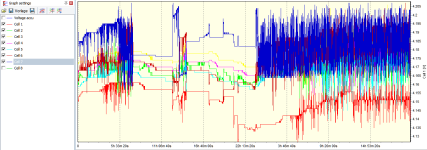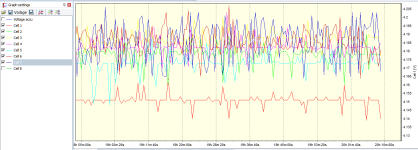mrbill
10 kW
In early 2014 I purchased a number of Lithium batteries from EM3EV, built from the Samsung INR-18650-29E cells. Four batteries are configured as 7s9p, and two are configured as 7s12p. EM3EV supplied at my request a "2-wire" (same charge and discharge circuit) BMS for each battery. The BMS is sealed inside the battery, so it cannot be examined. Each battery includes an 8-pin JST-XH connector that can be attached to a Cellog 8S to record cell data or to allow manual cell charging/discharging, as needed. Overall, I have been happy with these batteries.
Every year in January I run a capacity test on each battery to determine what my usable capacity is for the coming year.
Each battery is charged until the first cell reaches 4.2volts, when the BMS cuts off charge current to the entire battery. The charger holds the top voltage for at least another 12 hours to assure that cell balancing is completed before I run the discharge test. For the discharge test I connect a Cellog 8s to record cell voltages while I discharge each battery at 12-18 Amps through a calibrated Cycle Analyst into a resistive load.
After the test is complete, I record the year's test results and add them to my blog.
https://mrbill.homeip.net/hybridBike.php#batteryCapacityTesting
This year I noticed that on all but two of the batteries Cell 7, the most positive cell, was consistently high during the entire discharge. On a couple of batteries Cell 6 and Cell 1 were also high. It appeared that the BMS was unable to balance all of the cells. I was able to observe the BMS balancing cells at the top of charge on the Cellog 8s display, and the BMS otherwise appears to function normally in the critical matter of cutting off charge current when the first cell hits 4.2 volts and discharge current when the first cell drops to 2.75 volts.
On the batteries that exhibited cell imbalance I manually discharged the cells with high voltage until those high cells showed a voltage less than the average cell voltage. Then I resumed the overall charge until the BMS again shut off charge current as the first cell hit 4.2 volts.
On all batteries that I manually balanced in this manner I was able to increase the total capacity. On one battery I was able to increase the capacity by 10% after manually balancing the cell voltage.
I was disappointed to observe with one battery that I had manually balanced and then charged normally, leaving the battery sitting at its top voltage for 24 hours, that Cell 7 on that battery was again resting at a higher voltage than the other cells.
Questions:
1) Why is Cell 7 consistently charged/balanced to a higher voltage than the other cells?
2) How many other customer's batteries may be exhibiting loss of capacity not from changes in chemistry but from creeping cell imbalance caused by insufficient or a faulty balancing function in the BMS?
Every year in January I run a capacity test on each battery to determine what my usable capacity is for the coming year.
Each battery is charged until the first cell reaches 4.2volts, when the BMS cuts off charge current to the entire battery. The charger holds the top voltage for at least another 12 hours to assure that cell balancing is completed before I run the discharge test. For the discharge test I connect a Cellog 8s to record cell voltages while I discharge each battery at 12-18 Amps through a calibrated Cycle Analyst into a resistive load.
After the test is complete, I record the year's test results and add them to my blog.
https://mrbill.homeip.net/hybridBike.php#batteryCapacityTesting
This year I noticed that on all but two of the batteries Cell 7, the most positive cell, was consistently high during the entire discharge. On a couple of batteries Cell 6 and Cell 1 were also high. It appeared that the BMS was unable to balance all of the cells. I was able to observe the BMS balancing cells at the top of charge on the Cellog 8s display, and the BMS otherwise appears to function normally in the critical matter of cutting off charge current when the first cell hits 4.2 volts and discharge current when the first cell drops to 2.75 volts.
On the batteries that exhibited cell imbalance I manually discharged the cells with high voltage until those high cells showed a voltage less than the average cell voltage. Then I resumed the overall charge until the BMS again shut off charge current as the first cell hit 4.2 volts.
On all batteries that I manually balanced in this manner I was able to increase the total capacity. On one battery I was able to increase the capacity by 10% after manually balancing the cell voltage.
I was disappointed to observe with one battery that I had manually balanced and then charged normally, leaving the battery sitting at its top voltage for 24 hours, that Cell 7 on that battery was again resting at a higher voltage than the other cells.
Questions:
1) Why is Cell 7 consistently charged/balanced to a higher voltage than the other cells?
2) How many other customer's batteries may be exhibiting loss of capacity not from changes in chemistry but from creeping cell imbalance caused by insufficient or a faulty balancing function in the BMS?





